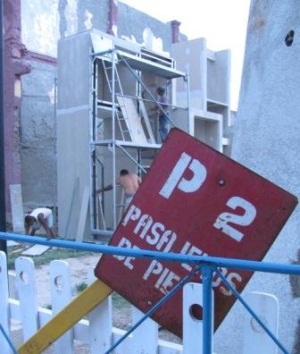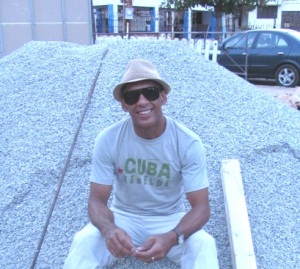
By Hector Bosch and Xenia Reloba
“It’s an amusement park”. “A craftwork fair”. “They are going to build a gallery of stores”. At P2’s first bus stop, 3rd and E corner (Vedado), people curiously observe the neighboring park, which was recently fenced in, so none of the regular passengers of the route to the remote Cotorro could figure out the purpose of such movement of young people. A grumpy old man scratches his head: “And now what the #$%& are they going to do here?”
A group of students of Fine Arts from the Superior Institute of Art comes and goes and their ins and outs are more and more frequent. Project Ciudad generosa, under the tutelage of Cuban artist and professor Rene Francisco, stands in the site where there were other things, and recently some banks yearning for noble vegetation.
We have arrived in early. The professor isn’t here and nobody knows if he is coming today. This city follows the accelerated rhythm of the inaugurations related to the 11th Biennial of Havana, and probably has other commitments. So we walk away, looking forward to finding him later. And that was what happened.
«But everybody asks me», those are his welcome words after having kindly listened to who we are and what we are doing here. «Talk to the boys. They can explain everything. There you have Anabel, Yami, Fidel… This is a class exercise », he insists while aims with the last phrase at the first of the girls and asks her to dialogue with the representatives of Arte por Excelencias.
«My piece is an asbestos cement bell. A video-art is going to be screened in the ceiling, representing a drop of water that falls on a supposed liquid surface. It’s very surrealist, bringing about a feeling of withdrawal, as well as a relaxing effect», Anabel Zenea explains, who is one of the thirteen pupils of Rene Francisco.
«Ciudad generosa tries to create a space in which viewers can feel themselves welcomed. Besides, every house offers a gift to the people», she tells us, before entering areas that turn out to be more winding, even for experienced artists.
«Artists have their own utopia and ask themselves how to materialize project? We have had to contact architects and different experts so as to get what we imagined», she says, and underlines the importance of going out of the galleristic context to establish a relation with the neighborhood.
«The work with Rene has made us grow up, as he leads us to the factors that get things done. He encourages us to reach the utopia. This project has taken us to make arrangements that are not usual for most of the artists. When this moment comes to an end, we’ll have higher stakes», she summarizes.

At the end of the way
Yamisleisy Garcia Socarras (Yami) probably never had a tree house. «Actually, although my work is based on some trends of Cuban architecture, I did some research and found the idea in the culture of other countries», she confesses while evokes that space, which in other places becomes a sort of refugee where children «escape» from their homes and hide their most intimate world.
Yami wants to give us, and give Ciudad generosa, a dreamed space and a space to dream, which does well out of the location of her piece, at the end of the road, the yard, and at a height that allows those who visit it to admire the surroundings and reflect on what’s going on around them.
Like her colleagues, she will be given present too: some small wooden chests for visitors to keep their treasures. «I can’t control the reaction of viewers. What I want is to provide an image that is not familiar to them or they have forgotten it: the opportunity of having the most perfect tree house», she emphasizes.
From a more conceptual outlook, Yami explains: «Casa generosa would be similar to an art institution, a micro-world within the macro-world represented by the city».
In a discourse where generosity prevails all the time, the young artist, who will be flying in a couple of year without the tutelage of her professor, explains that he has taught them to be organized, present projects and look for resources. «This production has required a lot of effort. Although every structure is different, all of us worked together to find sponsors», she concludes.
The En Construccion piece stands in one of the lateral limits of the city. It’s the only artwork designed not to be ready on Saturday 12, in the afternoon, when this collective project is scheduled to be inaugurated. Its author, Nelson Barrera Hernandez, explains that it’s a sort of building designed to support other previous works, autonomous, installations and paintings among them.
What are you going to give to the visitors as a present?, we asked him, and the quick answer was: «construction materials». Another metaphor of reality that returns subverted. «It’s not a projection that tries to solve problems, but it’s a gesture», he insists, while points out the ephemeral character of this city, which contrasts with the idea transcendental and eternal metropolis.
«As for the pedagogical pragmatic, it has to do with the preparation to face a productive process linked to the creation. This entails a work dynamic that is different from the one followed by an artist in a workshop and helps us to face the social life, go out and not to stay at the ISA, as an isolation place», he explains.

Ineludible Coda
Rene Francisco
Rene Francisco, 2010 National Award of Fine Arts, walks from one place to another as we speak to him. We have already talked to three students but, even so, we have three questions. The first one: How does this collective project joins the proposal of the 11th Biennial, which targets artistic practices and social imaginaries, keeping in mind that one of the most constant problems in Cuban reality is related to the housing matter?
«Paradoxically, title Ciudad generosa seems to be a kind of noble thing, when it comes to a problem that has been felt for many years: how do Cuban people live, not only in terms of way of life but space. I think that the title that seems to add distinction to this idea involves a profound critic, not in the complaint style. It’s the way of artists who criticize, criticize and criticize», he begins.
«I’ve look into the opposite side of the question. For us, a group of students and one professor, a 40.000 CUC investment is a lot of money, but it’s not so for the State. Somehow, this work shows that many things can be done with that money», the artist notes, and confesses to be amazed by the ability of his students when it comes to facing big challenges.
«Sometimes I feel like a strange when the people are looking at us, how we build with these materials things that that could solve…», he stops, because he had rather tell, just as he did in other works, how to use these materials to repair their houses.
«But we want to build a parallel city», he insists, «to show that a metropolis can hypothetically exist, and not only state-run institutions, but also the neighbors have gotten used to live in these circumstances». And he continues: «Cuban people can be easily modeled and I think that there are people who adapt, who have lived in a level, get adapted to a lower one and go down».
The «pedagogic fact» has an extraordinary importance for him. Watching «how young artists can prove, by using terms that we usually put aside –due to the cynicism present on the intellectual and artistic practice–, terms like humanism, beauty, emotion. I want to bring those things excluded from the contemporary intellect», he insists, and thinks of what has been –evidently– one of his greatest motivations in recent years: «I vote for that union between pedagogy and art, of how you can edify to send signals to the people».
Few days before the inauguration, and though he told us that he’s working as a building worker and can’t think about any other thing but construction, Rene Francisco can’t stop reflecting on this project that kicked off as a class exercise, has grown up and presently transforms –although it’s just for one month– a popular and many times overwhelmed site in Vedado: «I don’t think that we have come to the Biennial, but the Biennial came to us. I’ve been working this way since 1990. I’ve always dealt with this urban topic, how to insert the creation in the streets, outside».
And he is interested in «how to train people to deal with the public, talk to viewers, not looking to the past but to the future question», and it’s also a pragmatic project in that sense because it aims at how to go on.
Because this Ciudad generosa is «like from the future», we can dream about it, and it includes the best of Cuban architecture, the beauty and spirit that accompanied it, even in the worst times. The metropolis brought back by Rene and his 4th Pragmatic crew, beyond our apparently uncontrollable immoderation.
And though we had announced «three questions», the truth prevails: «Do you know what? It’s been enough».










